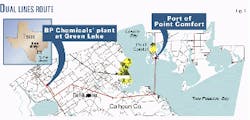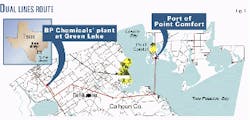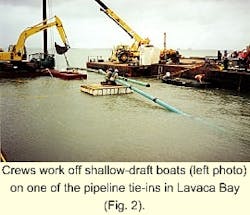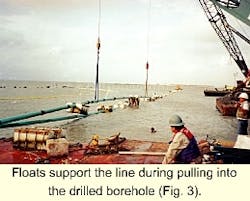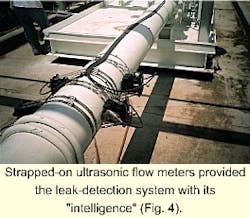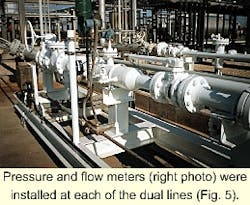Environmental solutions key successful South Texas line installation
The BP Amoco Chemicals Green Lake, Tex., pipeline project was, at the time of its construction in May 1999, the world's longest directionally drilled pipeline.
Moreover, designing and building it required protecting a variety of sensitive environments surrounding the lines and ensuring containment of hazardous products within the pipelines.
Stringent requirements imposed by BP Amoco Chemicals exceeded even those of the US Environmental Protection Agency (EPA), Department of Transportation (DOT), and the US Army Corps of Engineers.
Project participants engineered and used advanced technological safeguards coupled with construction methods to address environmental sensitivity. Namely, construction employed the world's longest directionally drilled pipeline crossing and a sophisticated leak-detection system, all to protect the marine environment through which the line passes.
Project
The Green Lake project involved the construction of two 25-mile, 85/8-in. OD, bi-directional pipelines. Each line incorporates metering stations and three block-valve stations; and a sophisticated leak-detection system monitors both lines.
One of the pipelines is designated for the transport of acrylonitrile, the finished product of BP Amoco Chemicals' Green Lake plant, to the Port of Port Lavaca/Point Comfort terminal on the eastern shore of Lavaca Bay in South Texas (Fig. 1).
The other line carries anhydrous ammonia, one of the main process ingredients in the manufacture of acrylonitrile, from the port to the plant.
Each line consists of two segments: a 19.6-mile onshore portion and a 5.4-mile offshore segment running under Lavaca Bay.
Construction of the onshore portion utilized conventional excavation and burial technology. Use of a highly sensitive and fast-responding leak-detection system differentiated this portion of the line from typical oil and gas transmission lines.
Construction of the offshore portion, however, necessitated a more creative approach. Lavaca Bay is a designated EPA Superfund site for its mercury-containing sediments. Reducing disturbance of these sediments meant that the lines had to be directionally drilled under the bay and, at the time, was the longest recorded.
Transported products
Acryonitrile is manufactured in an ammoxidation process, combining propylene, oxygen, and ammonia in a high-temperature fluid-bed reactor. The product is used in the manufacture of fabrics and high impact plastics. The hazardous liquid is clear and colorless with a slight pungent odor. It is toxic and subject to polymerization.
BP Amoco Chemicals has manufactured acrylonitrile for almost 50 years and has implemented comprehensive safety, storage, and handling procedures for the product. Within the pipeline, the designed flow range for acrylonitrile is between 350 and 1,000 gpm with a viscosity of 0.34 cp and a standard operating pressure of 525 psig.
Anhydrous ammonia is a colorless, nonflammable gas with a strong odor. It is toxic and can cause breathing problems and irritation to the eyes. It is shipped as a liquefied gas under its own pressure of 114 psig.
The designed flow rate for ammonia in the Green Lake project was 100-400 gpm with a flowing viscosity of 0.14 cp and operating pressure of 350 psig.
The principal areas of scrutiny and special attention for environmental preservation were the offshore construction and pipe laying phases of the project and the sophisticated leak-detection system employed, in addition to typical instrumentation and control schemes.
Each of these areas was addressed in consultation with and supervision by BP Amoco Chemicals engineers.
Offshore construction
The decision to drill directionally beneath Lavaca Bay was prompted by its designation as an EPA Superfund site, with mercury-contaminated sediment that could have been significantly dispersed with the use of conventional trenching and post-jetting burial methods.
Additionally, the bay is a nesting area for migratory birds. Directional drilling, as an alternative to traditional pipelay methods, created minimal disturbance to this sanctuary and to the bay's sensitive ecological balance in these commercially productive fishing waters.
Harding Directional Drilling Co., Bryan, Tex., made a total of nine offshore drills. Each was about 4,000-5,000 ft long and 20 in. diameter for bundling of the two 85/8-in. lines. Four of the drill sections were made up onshore.
The Grade X-42, 0.438-in. WT carbon steel line pipe used in the water lay was supplied by Lone Star Steel, Lone Star, Tex., and was fusion-bonded epoxy coated by A&A Coating, Lone Star.
The balance of the drill sections was fabricated on the lay barge to reduce difficulties and disruptions in floating the lines to the pull sites. Severe weather conditions, as a result of Tropical Storm Charlie, complicated the installation and further prompted the decision to fabricate the lines offshore.
Drills were made to a depth of 30 ft in the bay crossing, deepening to 80 ft at points 50 ft on either side of the 36-ft wide deep-draft channel.
This depth complied with Corps of Engineers' clearance requirements while accommodating future dredging without interference with the pipelines.
Pipeline tie-ins were about 200 ft in length. Operating in 4-ft water depths prompted the use of shallow-draft work barges (Fig. 2). Pipelines entered the tie-in areas at a 5° pitch with cranes lifting each pipe segment from both boreholes into cradles on the work barge.
Floats were added to support the pipe between the boreholes and the barge (Fig. 3). Once the pipe was welded, X-rayed, field joint coated, insulated, and "jeeped" (inspected for coating gaps or unacceptably thin areas called "holidays"), the pipe was lowered with minimal sediment water bottom disruption.
As a Corps of Engineers requirement, the first drill water and soil were tested to ascertain that there had been no mercury level increase or particulate resuspension as a consequence of drilling.
Silt fencing surrounded the drill sites at each location further to protect the bay bottom migration.
Drilling fluids were selected for their environmental compatibility. High yield Bentonite (220 bbl/ton) provided the base fluid used for hole cleaning, bit lubrication, and weighting. Soda ash was used for pH control and for reducing the water hardness of the fresh mix water barged to the work site from shore for fluids makeup.
A high molecular weight, water-soluble cellulose polymer was used to control fluid loss and rheology. This environmentally safe fluid was important for the stabilization of the soft clay drilling formation, keeping the hole in gauge without swelling and erosion. All spent fluids were barged to shore for safe, noncontaminating disposal.
Once completed, the offshore line was pretested and 100% X-rayed to BP Amoco and DOT specifications. The test section was flooded with fresh water behind a fill pig and hydrostatically tested to 2,180-psig test pressure maintained for 8 hr.
Leak-detection
The toxic product and feedstock requires a sophisticated leak-detection system capable of rapid response to small leaks. It is supported by dedicated flow and pressure metering, automated valves, and control instrumentation.
The system, manufactured by EFA Technologies Inc., Sacramento, incorporates two independent methods of leak detection and intelligent alarm processing for flowing conditions and an even higher level of sensitivity during static periods between shipments. The lines are monitored continually.
As a means to provide a rapid response to any detected leak, each pipeline was outfitted with three land-based block valves, located equidistantly between the western edge of Lavaca Bay and the Green Lake plant.
Each of these trunnion-mounted ball valves is equipped with remotely operated, electric valve actuators and flanked by smart digital pressure gauges on either side for continuous monitoring regardless of valve position.
Pressure transmitters at the ends of each pipeline provide the primary leak-detection inputs to the detection system, LeakNet. The instruments at the valve stations are used during static monitoring and also provide redundancy should the main system fail.
At both the plant and the port terminal are pneumatically actuated emergency shut-down valves positioned to shut in the lines completely, if necessary. Strap-on ultrasonic flow meters at each end of the pipelines provide the flow signals used to make the leak-detection system "intelligent" (Fig. 4).
Bi-directional custody transfer-quality meter and provers, at each end of each pipeline, are used exclusively in a secondary leak-detection role.
The EFA leak-detection system uses the patented proprietary Pressure Point Analysis (PPA) algorithm.
During flow operation, PPA monitors both the pressure and the flow rate at each end of the line (Fig. 5). The algorithm statistically evaluates the current pipeline flow rate and pressure, analyzing the data for patterns characteristic of a leak.
Intelligent alarm processing determines whether the changes seen in the hydraulic noise in the line are due to changes in pumping activity or to a leak. Detection time, even on very small leaks, is within 1 or 2 min of the actual event.
During static conditions, the same PPA algorithm monitors the intermediate pressure instruments. Leaks as small as 4 ppm can be detected within 5-10 min of the actual event. The increase in sensitivity results from the lack of hydraulic noise associated with the pumping process. Detection can be made on a pressure loss as small as 0.1 psig.
A second, independent detection method has also been employed as part of the system.
Mass Pack, a proprietary mass-balance system, monitors flow into and out of the specific pipeline. The meter imbalance is monitored on accumulators set for 1 min, 60 min, 24 hr, and 1 month. This method accurately measures changes in the line pack.
It is included as a means to detect leaks that would otherwise be lost in the hydraulic noise while the line is flowing. PPA detects leaks that are less than the accuracy of the meter during the static periods of the line.
In keeping with the thrust of pending regulations, the leak-detection system was installed as a completely independent system. Field data are gathered by Modicon programmable logic controllers, which pass data directly to LeakNet.
The controllers also pass data to the plant's supervisory control and data acquisition (SCADA) system for collection and dissemination to a dedicated personal computer in the control room.
Historical archiving of the pipeline operation and alarm logs is maintained on LeakNet, freeing up hard drive space in the SCADA system for operational tasks.
EFA trainers were on site to assist in start-up and to test the sensitivity and accuracy of the system. The operators tuned LeakNet on-site during the training period.
Leak tests were conducted while the lines were filled with feedstock during both flowing conditions and while the lines were static. The system generated no nuisance alarms at the tuned levels.
Payoff
Water and soil testing following completion of the pipelay verified that aquatic life in Lavaca Bay was not damaged by the drilling. Additionally, on-line testing of the leak-detection system demonstrated that pipeline operation was well within safe tolerances.
The authors
Tony L. Council is senior consulting engineer for Mustang Engineering, Houston, which he joined in 1993. Previous employment included Conoco Inc. (1978-1988). Council holds a BS (1978) in mechanical engineering; he is a registered profession engineer in Texas.
Diane J. Hovey is an applications engineer for EFA Technologies Inc., Sacramento, and has been involved in pipeline leak detection since 1991. Before that time, Hovey worked as a design engineer for refinery and pipeline projects and was lead engineer for Ed Farmer & Associates Inc., Sacramento. She holds a masters and PhD from the University of Hawaii.
Michael L. Cox is a project manager for BP Amoco, Chicago, and has previously worked for Alyeska Pipeline Service Co. (1990-1997) and Schlumberger (1988-1990). He holds a BS (1986) in geological engineering from the University of Mississippi.
